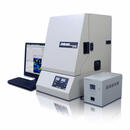Home > Technical Info > 動画ライブラリ > Cellgraph data

動画ライブラリ
Application data of Cellgraph
Real-time monitoring of bioluminescence image
Bioluminescent images are acquired from NIH3T3 cells expressing SV40 promoter fused luciferase with cellgraph. The merge images of bright field and bioluminescence shown as pseudo color.
Data analysis with dedicated software “Cellgraph viewer”
Cellgraph Viewer is an image analysis software. It is very simple and easy to use, and has multiple function such as luminescent intensity measurement, making movie and montage… etc.. The ROI mode in analysis tools provides the function to measure bioluminescent intensities individually in any given region of interest. The result of analyzing bioluminescence intensity data can be exported as CSV format files.
Bioluminescence imaging of a brain tissue slice containing the mouse hypothalamus superachiasmatic nucleus (SCN)
Using the Cellgraph system, a brain tissue slice from a transgenic mouse that express luciferase under control of the clock gene promoter were analyzed. The Brain was removed and sectioned into 100 µm thick slices using a Microslicer, each of which was then placed in a culture insert. The time-lapse images of an SCN section acquired over a period of five days using the Cellgraph system. Using the grid measurement function of “Cellgraph Viewer”, the bioluminescence intensity in each area was analyzed and quantified.
Time-lapse imaging of intracellular trafficking of importin α
Visualization of nucleocytoplasmic shuttling of importin α by the Cellgraph system. In this study, importin α gene fused with luciferase was expressed in NIH3T3 cells. The time-lapse images were acquired using three minutes exposure time at intervals of four minutes with a 40x objective lens without binning. The luminescence signal was initially detected in the cytosol, then in the nucleus. After that, the luminescence signal in the nucleus gradually increased. As shown above, the Cellgraph system is an ideal tool for observing biological events such as trafficking of proteins that occur over a prolonged period of time.
Reference: Y. Nakajima, PLoS One, 5(4), e10011 (2010) [PubMed]
Visualization of ATP oscillations in the early stage of chondrogenesis
Cellular condensation in embryonic limbs that occurs in the early stage of chondrogenesis is considered to play a critical role in the secretion of adhesion molecules and extracellular matrixes. The movie shows the visualization of ATP oscillation after the induction of chondrogenesis in ATCD5 cells transfected with an ATP-dependent Phyxothrix hirtus luciferase gene. As demonstrated in this study, the Cellgraph system is an effective tool for examining intracellular metabolic mechanisms.
Reference: H. Kwon, Cell Death Disease, 3. e278 (2012) [PubMed]
Apoptosis analysis
Cells were transfected with luciferase reporter gene fused to nuclear targeting signal sequence. Cells were stimulated with STS (1μM) and observed by Cellgraph. Cellgraph system enable us to visualize apoptotic phenomena such as nuclear fragmentation and membrane rupture in apoptotic cells by STS stimulation.
Wound healing assay
The result of the wound healing assay observed with Cellgraph are shown in this movie. NIH3T3 cells stably expressing luciferase were cultured until fully confluent. Wounds were created by scraping monolayer cells with a sterile pipette tip. Then wound closure was monitored by Cellgraph.
Activation of GnRH neurons by kisspeptin stimulation
Ultradian rhythms of gonadotropin-releasing hormone (GnRH) gene transcription in single GnRH neurons were monitored using cultured hypothalamic slice prepared from transgenic mouse expressing a GnRH promoter-driven destabilized liciferase reporter. It was demonstrated that GnRH gene transcription was synchronously activated after kisspeptin was added to the media.
Reference: HK. Choe, Proc. Natl. Acad. Sci. U.S.A., 110(14), 5677-5682 (2013) [PubMed]
AB-3000B Cellgraph (product information)
Cellgraph AB-3000B is an imaging system to detect low-level light emission in a single living cell by using a highly sensitive EM-CCD camera.



